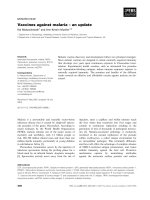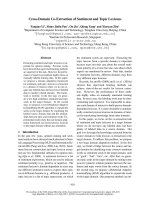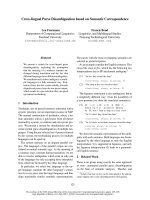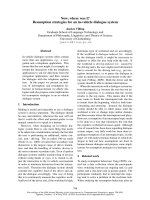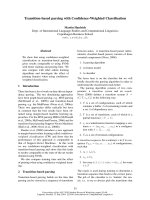Báo cáo khoa học: "Cross Lingual Adaptation: An Experiment on Sentiment Classifications" pdf
Bạn đang xem bản rút gọn của tài liệu. Xem và tải ngay bản đầy đủ của tài liệu tại đây (121.37 KB, 5 trang )
Proceedings of the ACL 2010 Conference Short Papers, pages 258–262,
Uppsala, Sweden, 11-16 July 2010.
c
2010 Association for Computational Linguistics
Cross Lingual Adaptation: An Experiment on Sentiment Classifications
Bin Wei
University of Rochester
Rochester, NY, USA.
Christopher Pal
´
Ecole Polytechnique de Montr
´
eal
Montr
´
eal, QC, Canada.
Abstract
In this paper, we study the problem of
using an annotated corpus in English for
the same natural language processing task
in another language. While various ma-
chine translation systems are available, au-
tomated translation is still far from per-
fect. To minimize the noise introduced
by translations, we propose to use only
key ‘reliable” parts from the translations
and apply structural correspondence learn-
ing (SCL) to find a low dimensional rep-
resentation shared by the two languages.
We perform experiments on an English-
Chinese sentiment classification task and
compare our results with a previous co-
training approach. To alleviate the prob-
lem of data sparseness, we create ex-
tra pseudo-examples for SCL by making
queries to a search engine. Experiments
on real-world on-line review data demon-
strate the two techniques can effectively
improve the performance compared to pre-
vious work.
1 Introduction
In this paper we are interested in the problem of
transferring knowledge gained from data gathered
in one language to another language. A simple and
straightforward solution for this problem might
be to use automatic machine translations. How-
ever, while machine translation has been the sub-
ject of a great deal of development in recent years,
many of the recent gains in performance manifest
as syntactically as opposed to semantically cor-
rect sentences. For example, “PIANYI” is a word
mainly used in positive comments in Chinese but
its translation from the online Google translator is
always “cheap”, a word typically used in a neg-
ative context in English. To reduce this kind of
error introduced by the translator, Wan in (Wan,
2009) applied a co-training scheme. In this setting
classifiers are trained in both languages and the
two classifiers teach each other for the unlabeled
examples. The co-training approach manages to
boost the performance as it allows the text simi-
larity in the target language to compete with the
“fake” similarity from the translated texts. How-
ever, the translated texts are still used as training
data and thus can potentially mislead the classifier.
As we are not really interested in predicting some-
thing on the language created by the translator,
but rather on the real one, it may be better to fur-
ther diminish the role of the translated texts in the
learning process. Motivated by this observation,
we suggest here to view this problem as a special
case of domain adaptation, in the source domain,
we mainly observe English features, while in the
other domain mostly features from Chinese. The
problem we address is how to associate the fea-
tures under a unified setting.
There has been a lot of work in domain adaption
for NLP (Dai et al., 2007)(Jiang and Zhai, 2007)
and one suitable choice for our problem is the ap-
proach based on structural correspondence learn-
ing (SCL) as in (Blitzer et al., 2006) and (Blitzer
et al., 2007b). The key idea of SCL is to identify a
low-dimensional representations that capture cor-
respondence between features from both domains
(x
s
and x
t
in our case) by modeling their correla-
tions with some special pivot features. The SCL
approach is a good fit for our problem as it per-
forms knowledge transfer through identifying im-
portant features. In the cross-lingual setting, we
can restrict the translated texts by using them only
through the pivot features. We believe this form is
more robust to errors in the language produced by
the translator.
Adapting language resources and knowledge to
a new language was first studied for general text
categorization and information retrieval as in (Bel
258
et al., 2003), where the authors translate a key-
word lexicon to perform cross-lingual text cate-
gorization. In (Mihalcea et al., 2007), different
shortcomings of lexicon-based translation scheme
was discussed for the more semantic-oriented task
subjective analysis, instead the authors proposed
to use a parallel-corpus, apply the classifier in the
source language and use the corresponding sen-
tences in the target language to train a new clas-
sifier. With the rapid development of automatic
machine translations, translating the whole corpus
becomes a plausible option. One can either choose
to translate a corpus in the target language and ap-
ply the classifier in the source language to obtain
labeled data, or directly translated the existing data
set to the new language. Various experiments of
the first strategy are performed in (Banea et al.,
2008) for the subjective analysis task and an aver-
age 65 F1 score was reported. In (Wan, 2008), the
authors propose to combine both strategies with
ensemble learning and train a bi-lingual classifier.
In this paper, we are also interested in explor-
ing whether a search engine can be used to im-
prove the performance of NLP systems through re-
ducing the effect of data sparseness. As the SCL
algorithm we use here is based on co-occurrence
statistics, we adopt a simple approach of creating
pseudo-examples from the query counts returned
by Google.
2 Our Approach
To begin, we give a formal definition of the prob-
lem we are considering. Assume we have two lan-
guages l
s
and l
t
and denote features in these two
languages as x
s
and x
t
respectively. We also have
text-level translations and we use x
t
for features
in the translations from l
s
to l
t
and x
s
for the
other direction. Let y be the output variable we
want to predict, we have labeled examples (y, x
s
)
and some unlabeled examples (x
t
). Our task is to
train a classifier for (y, x
t
). In this paper, we con-
sider the binary sentiment classification (positive
or negative) problem where l
s
and l
t
correspond to
English and Chinese (for general sentiment analy-
sis, we refer the readers to the various previous
studies as in (Turney, 2002),(Pang et al., 2002),and
(McDonald et al., 2007)). With these definitions
in place, we now describe our approach in further
detail.
2.1 Structural Correspondence
Learning(SCL)
Due to space limitations, we give a very brief
overview of the SCL framework here. For a
detailed illustration, please refer to (Ando and
Zhang, 2005). When SCL is used in a domain
adaptation problem, one first needs to find a set
of pivot features x
p
. These pivot features should
behave in a similar manner in both domains, and
can be used as “references” to estimate how much
other features may contribute when used in a clas-
sifier to predict a target variable. These features
can either be identified with heuristics (Blitzer
et al., 2006) or by automatic selection (Blitzer
et al., 2007b). Take sentiment classification as
an example, “very good” and “awful” are good
pivot features, if a certain feature in the target do-
main co-occurs often with “very good” but infre-
quently with “awful”, we could expect this fea-
ture will play a similar role as “very good” in
the final classifier but a different role from “aw-
ful”. We can make this observation purely based
on the co-occurrence between these features. No
hand-labeling is required and this specific feature
doesn’t need to be present in our labeled training
data of the source domain.
The SCL approach of (Ando and Zhang, 2005)
formulates the above idea by constructing a set
of linear predictors for each of the pivot fea-
tures. Each of these linear predictor is binary like
whether “very good” occurs in the text and we
have a set of training instances (1|0, {x
i
}). The
weight matrix of these linear predictors will en-
code the co-occurrence statistics between an or-
dinary feature and the pivot features. As the co-
occurrence data are generally very sparse for a typ-
ical NLP task, we usually compress the weight
matrix using the singular vector decomposition
and only selects the top k eigenvectors v
k
. This
matrix w of the k vectors {v
k
} gives a mapping
from the original feature space to a lower dimen-
sional representation and is shown in (Ando and
Zhang, 2005) to be the optimal choice of dimen-
sion k under common loss functions. In the next
step we can then train a classifier on the extended
feature (x, w ∗ x) in the source domain. As w
groups the features from different domains with
similar behavior relative to the pivot features to-
gether, if such a classifier has good performance
on the source domain, it will likely do well on the
target domain as well.
259
2.2 SCL for the Cross-lingual Adaptation
Viewing our task as a domain adaptation prob-
lem. The source domain correspond to English
reviews and the target domain for Chinese ones.
The full feature vector is (x
s
, x
t
). The difficulty
we are facing is, due to noise in the translations,
the conditional probabilities p(y|x
s
) and the one
in the translated texts p(y|x
s
) may be quite differ-
ent. Consider the following two straightforward
strategies of using automatic machine translations:
one can translate the original English labeled data
(y, x
s
) into (y, x
t
) in Chinese and train a clas-
sifier, or one can train a classifier on (y, x
s
) and
translate x
t
in Chinese into x
s
in English so as to
use the classifier. But as the conditional distribu-
tion can be quite different for the original language
and the pseudo language produced by the machine
translators, these two strategies give poor perfor-
mance as reported in (Wan, 2009).
Our solution to this problem is simple: instead
of using all the features as (x
s
, x
t
) and (x
s
, x
t
),
we only preserves the pivot features in the trans-
lated texts x
s
and x
t
respectively and discard the
other features produced by the translator. So, now
we will have (x
s
, x
tp
) and (x
sp
, x
t
) where x
(s|t)p
are pivot features in the source and the target lan-
guages. In other words, when we use the SCL on
our problem, the translations are only used to de-
cide if a certain pivot feature occurs or not in the
training of the linear predictors. All the other non-
pivot features in the translators are blocked to re-
duce the noise.
In the original SCL as we mentioned earlier,
the final classifier is trained on the extended fea-
tures (x, w ∗ x). However, as mentioned above
we will only use the pivot features. To represent
this constraint, we can modify the vector to be
(w
p
∗ x, w ∗ x) where w
p
is a constant matrix that
only selects the pivot features. This modification
will not affect the deduction procedure and results
in (Ando and Zhang, 2005). Experiments show
that using only pivot features actually outperforms
the full feature setting.
For the selection of the pivot features, we fol-
low the automatic selection method proposed in
(Blitzer et al., 2007a). We first select some candi-
dates that occur at least some constant number of
times in reviews of the two languages. Then, we
rank these features according to their conditional
entropy to the labels on the training set. In table
1, we give some of the pivot features with English
English Pivot Features
“poor quality”, “not buy”, “easy use”, “very easy”
“excellent”, “perfect”, “still very”, “garbage”,
“poor”, “not work”, “not to”, “very comfortable”
Chinese Pivot Features
wanmei(perfect), xiaoguo hen(effect is very )
tisheng(improve),feichang hao(very good),
cha(poor), shushi(comfortable), chuse(excellent)
Table 1: Some pivot features.
translations associated with the Chinese pivot fea-
tures. As we can see from the table, although
we only have text-level translations we still get
some features with similar meaning from differ-
ent languages, just like performing an alignment
of words.
2.3 Utilizing the Search Engine
Data sparseness is a common problem in NLP
tasks. On the other hand, search engines nowadays
usually index a huge amount of web pages. We
now show how they can also be used as a valuable
data source in a less obvious way. Previous studies
like (Bollegala, 2007) have shown that search en-
gine results can be comparable to language statis-
tics from a large scale corpus for some NLP tasks
like word sense disambiguation. For our problem,
we use the query counts returned by a search en-
gine to compute the correlations between a normal
feature and the pivot features.
Consider the word “PIANYI” which is mostly
used in positive comments, the query “CHAN-
PIN(product) PING(comment) CHA(bad) PI-
ANYI” has 2,900,000 results, while “CHAN-
PIN(product) PING(comment) HAO(good) PI-
ANYI” returns 57,400,000 pages. The results im-
ply the word “PIANYI” is closer to the pivot fea-
ture “good” and it behaves less similar with the
pivot feature “bad”.
To add the query counts into the SCL scheme,
we create pseudo examples when training lin-
ear predictors for pivot features. To construct a
pseudo-positive example between a certain feature
x
i
and a certain pivot feature x
p
, we simply query
the term x
i
x
p
and get a count c
1
. We also query
x
p
alone and get another count c
2
.Then we can
create an example (1, {0, , 0, x
i
=
c
1
c
2
, 0, , 0 }).
The pseudo-negative examples are created simi-
larly. These pseudo examples are equivalent to
texts with a single word and the count is used to
260
approximate the empirical expectation. As an ini-
tial experiment, we select 10,000 Chinese features
that occur more than once in the Chinese unla-
beled data set but not frequent enough to be cap-
tured by the original SCL. And we also select the
top 20 most informative Chinese pivot features to
perform the queries.
3 Experiment
3.1 Data Set
For comparsion, we use the same data set in (Wan,
2009):
Test Set(Labeled Chinese Reviews): The data
set contains a total of 886 labeled product reviews
in Chinese (451 positive reviews and 435 negative
ones). These reviews are extracted from a popular
Chinese IT product website IT168
1
. The reviews
are mainly about electronic devices like mp3 play-
ers, mobile phones, digital cameras and comput-
ers.
Training Set(Labeled English Reviews): This
is the data set used in the domain adaption exper-
iment of (Blitzer et al., 2007b). It contains four
major categories: books, DVDs, electronics and
kitchen appliances. The data set consists of 8000
reviews with 4000 positive and 4000 negative, It is
a public data set available on the web
2
.
Unlabeled Set (Unlabeled Chinese Reviews):
1000 Chinese reviews downloaded from the same
website as the Chinese training set. They are of
the same domain as the test set.
We translate each English review into Chinese
and vice versus through the public Google Trans-
lation service. Also following the setting in (Wan,
2009), we only use the Chinese unlabeled data and
English training sets for our SCL training proce-
dures. The test set is blind to the training stage.
The features we used are bigrams and unigrams
in the two languages as in (Wan, 2009). In Chi-
nese, we first apply the stanford Chinese word seg-
menter
3
to segment the reviews. Bigrams refers
to a single Chinese word and a bigram refers to
two adjacent Chinese words. The features are also
pre-processed and normalized as in (Blitzer et al.,
2007b).
1
2
mdredze/datasets/sentiment/
3
/>Models Precision Recall F-Score
CoTrain 0.768 0.905 0.831
SCL-B 0.772 0.914 0.837
SCL-C 0.764 0.896 0.825
SCL-O 0.760 0.909 0.828
SCL-E 0.801 0.909 0.851
Table 2: Results on the Positive Reviews
Models Precision Recall F-Score
CoTrain 0.879 0.717 0.790
SCL-B 0.931 0.752 0.833
SCL-C 0.908 0.743 0.817
SCL-O 0.928 0.739 0.823
SCL-E 0.928 0.796 0.857
Table 3: Results on the Negative Reviews
3.2 Comparisons
We compare our procedure with the co-training
scheme reported in (Wan, 2009):
CoTrain: The method with the best perfor-
mance in (Wan, 2009). Two standard SVMs are
trained using the co-training scheme for the Chi-
nese views and the English views. And the results
of the two SVMs are combined to give the final
output.
SCL-B: The basic SCL procedure as explained.
SCL-O: The basic SCL except that we use all
features from the translated texts instead of only
the pivot features.
SCL-C: The training procedure is still the same
as SCL-B except in the test time we only use
the Chinese pivot features and neglect the English
pivot features from translations.
SCL-E: The same as SCL-B except that in the
training of linear pivot predictors, we also use the
pseudo examples constructed from queries of the
search engine.
Table 2 and 3 give results measured on the pos-
itive labeled reviews and negative reviews sep-
arately. Table 4 gives the overall accuracy on
the whole 886 reviews. Our basic SCL approach
SCL-B outperforms the original Co-Training ap-
proach by 2.2% in the overall accuracy. We can
CoTrain SCL-B SCL-O SCL-C SCL-E
0.813 0.835 0.826 0.822 0.854
Table 4: Overall Accuracy of Different Methods
261
also notice that using all the features including the
ones from translations actually deteriorate the per-
formance from 0.835 to 0.826.
The model incorporating the co-occurrence
count information from the search engine has the
best overall performance of 0.857. It is interesting
to note that the simple scheme we have adopted in-
creased the recall performance on the negative re-
views significantly. After examining the reviews,
we find the negative part contains some idioms and
words mainly used on the internet and the query
count seems to be able to capture their usage.
Finally, as our final goal is to train a Chinese
sentiment classifier, it will be best if our model
can only rely on the Chinese features. The SCL-
C model improves the performance from the Co-
Training method a little but not as much as the
SCL − B and the SCL − O approaches. This
observation suggests that the translations are still
helpful for the cross-lingual adaptation problem
as the translators perform some implicit semantic
mapping.
4 Conclusion
In this paper, we are interested in adapting ex-
isting knowledge to a new language. We show
that instead of fully relying on automatic trans-
lation, which may be misleading for a highly se-
mantic task like the sentiment analysis, using tech-
niques like SCL to connect the two languages
through feature-level mapping seems a more suit-
able choice. We also perform an initial experiment
using the co-occurrence statistics from a search
engine to handle the data sparseness problem in
the adaptation process, and the result is encourag-
ing.
As future research we believe a promising av-
enue of exploration is to construct a probabilistic
version of the SCL approach which could offer a
more explicit model of the relations between the
two domains and the relations between the search
engine results and the model parameters. Also,
in the current work, we select the pivot features
by simple ranking with mutual information, which
only considers the distribution information. Incor-
porating the confidence from the translator may
further improve the performance.
References
Rie Kubota Ando and Tong Zhang. 2005. A frame-
work for learning predictive structures from multi-
ple tasks and unlabeled data. Journal of Machine
Learning Research.
Carmen Banea, Rada Mihalcea, Janyce Wiebe, and
Samer Hassan. 2008. Multilingual subjectivity
analysis using machine translation. In Proceedings
of EMNLP.
Nuria Bel, Cornelis H. A. Koster, and Marta Ville-
gas. 2003. Cross-lingual text categorization. In
Research and AdvancedTechnology for Digital Li-
braries.
John Blitzer, Ryan McDonald, and Fernando Pereira.
2006. Domain adaptation with structural correspon-
dence learning. In Proceedings of EMNLP.
John Blitzer, Koby Crammer, Alex Kulesza, Fernando
Pereira, and Jennifer Wortman. 2007a. Learning
bounds for domain adaptation. In Proceedings of
NIPS.
John Blitzer, Mark Dredze, and Fernando Pereira.
2007b. Biographies, bollywood, boom-boxes and
blenders: Domain adaptation for sentiment classi-
fication. In Proceedings of ACL.
Danushka Bollegala. 2007. Measuring semantic sim-
ilarity between words using web search engines. In
Proceedings of WWW 07.
Wenyuan Dai, Gui-Rong Xue, Qiang Yang, and Yong
Yu. 2007. Co-clustering based classification for
out-of-domain documents. In Proceedings of KDD.
Jing Jiang and ChengXiang Zhai. 2007. A two-stage
approach to domain adaptation for statistical classi-
fiers. In Proceedings of CIKM.
Ryan T. McDonald, Kerry Hannan, Tyler Neylon, Mike
Wells, and Jeffrey C. Reynar. 2007. Structured
models for fine-to-coarse sentiment analysis. In
Proceedings of ACL.
Rada Mihalcea, Carmen Banea, and Janyce Wiebe.
2007. Learning multilingual subjective language via
cross-lingual projections. In Proceedings of ACL.
Bo Pang, Lillian Lee, and Shivakumar Vaithyanathan.
2002. Thumbs up? sentiment classification us-
ing machine learning techniques. In Proceedings of
EMNLP.
Peter D. Turney. 2002. Thumbs up or thumbs down?
semantic orientation applied to unsupervised classi-
fication of reviews. In Proceedings of ACL.
Xiaojun Wan. 2008. Using bilingual knowledge and
ensemble techniques for unsupervised chinese sen-
timent analysis. In Proceedings of EMNLP.
Xiaojun Wan. 2009. Co-training for cross-lingual sen-
timent classification. In Proceedings of ACL.
262


